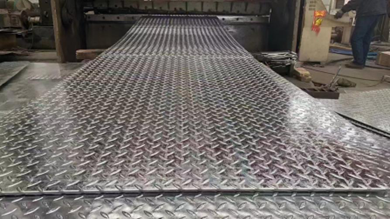Stainless steel checker plates are essential components in a variety of industries, from construction to manufacturing. Known for their strength, corrosion resistance, and non-slip properties, these plates are used in environments where durability and safety are paramount. However, one crucial factor to consider when purchasing stainless steel checker plates is their cost. Working with reliable stainless steel sheet suppliers can help you navigate pricing, quality, and availability. Understanding the pricing structure is vital for businesses and individuals alike, as it helps in budgeting and making informed purchasing decisions.
In this comprehensive pricing guide, we will explore the factors that influence the cost of stainless steel checker plates. From material grade to thickness, surface finish, and more, we will break down what you can expect to pay and why.
Factors That Influence the Price of Stainless Steel Checker Plates
When considering the cost of stainless steel checker plates, several factors come into play. Below are some of the most significant factors that can impact pricing.
1. Material Grade
The grade of stainless steel used in checker plates has a direct effect on the price. Stainless steel checker plates are available in various grades, with the most common being 304, 316, and 430.
304 Stainless Steel Checker Plate: This is the most commonly used grade, known for its excellent corrosion resistance and good formability. Its price is generally in the mid-range, making it a popular choice for both commercial and industrial applications.
316 Stainless Steel Checker Plate: This grade offers superior corrosion resistance, particularly in marine and acidic environments. The added molybdenum in 316 stainless steel increases its price compared to 304. It is often used in industries where exposure to harsh chemicals or saltwater is common.
430 Stainless Steel Checker Plate: This is a more cost-effective option compared to 304 and 316. While it lacks the corrosion resistance of the higher grades, it is still suitable for applications where corrosion is less of a concern. It is often used in indoor environments.
The choice of material grade will significantly affect the overall cost. Expect to pay more for 316 stainless steel checker plates, while 430-grade plates will be on the lower end of the pricing spectrum.
2. Plate Thickness
Another critical factor in the pricing of stainless steel checker plates is thickness. The thicker the plate, the more material is used, leading to a higher cost.
Standard Thickness Range: Stainless steel checker plates typically range from 3 mm to 12 mm in thickness. Thinner plates are often used for flooring in areas with lighter foot traffic, while thicker plates are ideal for heavy-duty applications such as industrial walkways, ramps, or loading docks.
Price Impact: Thinner plates are more affordable, but they may not offer the same level of durability as thicker plates. For high-traffic or heavy-load areas, investing in a thicker plate, though more expensive, will ensure longevity and safety.
3. Surface Finish
The surface finish of the stainless steel checker plate can also impact the cost. Various finishes are available, with each offering different benefits in terms of aesthetics and corrosion resistance.
No. 1 Finish: This is the most basic finish, offering a matte surface with a rough texture. It is generally the least expensive finish and is ideal for industrial settings where appearance is less important.
2B Finish: A smoother, more reflective finish that provides good corrosion resistance. It is slightly more expensive than the No. 1 finish but is more versatile, being used in both industrial and commercial applications.
No. 4 Finish: Known as a brushed or satin finish, this surface treatment is more visually appealing and is commonly used in decorative applications. The cost is higher than both No. 1 and 2B finishes due to the additional polishing process.
Choosing the appropriate surface finish for your application will influence the final price. If aesthetics are a priority, expect to pay a premium for polished or brushed finishes.
4. Sheet Size and Customization
The size of the stainless steel checker plate also contributes to the cost. Standard sizes include 4 feet by 8 feet, but custom sizes are often required for specific projects. Custom sizing or cutting to length will increase the price due to the additional labor and material waste involved.
Standard Sizes: These are more cost-effective since they are produced in bulk. If your project allows for the use of standard sizes, you can save on cutting and customization costs.
Custom Sizes: Customization typically results in higher costs. The more specific your requirements, the more you should expect to pay. Whether it’s cut-to-length or unique dimensions, customization adds to the production process, increasing the overall price.
5. Quantity and Bulk Pricing
One of the most significant factors affecting the price of stainless steel checker plates is the quantity purchased. As with many materials, buying in bulk often leads to discounts and reduced per-unit costs.
Small Orders: Smaller orders of stainless steel checker plates tend to have higher prices per square foot due to the higher processing and shipping costs associated with lower quantities.
Bulk Orders: For large projects, ordering in bulk can significantly reduce the cost per unit. Many suppliers offer discounts for large-volume purchases, making it more economical for industrial-scale projects.
6. Geographic Location and Supplier
The location of your supplier can also impact the price of stainless steel checker plates. Local suppliers may offer more competitive pricing due to reduced shipping costs, while international suppliers may have higher prices due to tariffs, taxes, and long shipping distances.
Local Suppliers: Choosing a local supplier can save on shipping costs and reduce lead times. Additionally, working with a supplier close to your project site allows for better communication and easier customization.
International Suppliers: While international suppliers may offer a broader range of products, the costs associated with importing materials, including tariffs and shipping fees, can drive up the price. It’s essential to weigh the pros and cons of sourcing materials from international versus local suppliers.
7. Market Conditions
The price of stainless steel checker plates can fluctuate based on global market conditions. The cost of raw materials such as nickel, chromium, and molybdenum directly impacts the price of stainless steel. Supply chain disruptions, changes in demand, and fluctuations in commodity prices can all influence the cost of stainless steel checker plates.
Raw Material Prices: Nickel prices, in particular, play a significant role in the cost of stainless steel. When nickel prices rise, the cost of producing stainless steel checker plates also increases.
Global Supply Chain: Events such as trade disputes, natural disasters, or global pandemics can disrupt the supply chain, leading to price increases. Keeping an eye on market trends can help you make informed purchasing decisions and possibly secure better pricing by timing your purchase.
Average Pricing for Stainless Steel Checker Plates
While prices can vary depending on the factors outlined above, here are some general pricing ranges to give you an idea of what to expect.
304 Stainless Steel Checker Plate: Prices typically range from $2.50 to $3.50 per pound.
316 Stainless Steel Checker Plate: Due to the added molybdenum, 316-grade plates usually cost between $3.50 and $4.50 per pound.
430 Stainless Steel Checker Plate: As a more economical option, 430-grade plates generally range from $1.50 to $2.50 per pound.
These prices are subject to change based on market conditions, supplier, and other factors, but they provide a useful benchmark for budgeting purposes.
Conclusion
The cost of stainless steel checker plates depends on a variety of factors, including material grade, thickness, surface finish, customization, quantity, and market conditions. By understanding these factors, you can better anticipate the costs involved and make informed purchasing decisions.
When planning your next project, consider your specific needs and budget carefully. Whether you’re looking for corrosion resistance, aesthetic appeal, or high durability, there’s a stainless steel checker plate that fits your requirements. By selecting the right grade, finish, and supplier, you can ensure that you get the best value for your investment while meeting the demands of your project.




